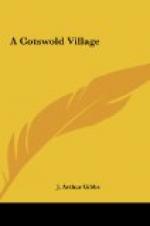If we would seek a lesson in sacrifice from the men who lived and laboured here in the remote past, we can learn many a one from those deep walls of native stone, and that laborious workmanship which was the chief characteristic of the toil of our simple ancestors. “All old work, nearly, has been hard work; it may be the hard work of children, of barbarians, of rustics, but it is always their utmost.” They may have been ignorant of the sanitary laws which govern health, and ill advised in some of the sites they chose, but they grudged neither hand labour nor sweat of brow; they spent the best years of their lives in the erection of the temples where we still worship and the manor houses we still inhabit.
It is not claimed that there is much ornamental architecture to be found in these Cotswold buildings; it is something in these days if we can boast that there is nothing to offend the eye in a district which is less than a hundred miles from London. There is no other district of equal extent within the same radius of which as much could be said.
“Jam pauca aratro
jugera regiae
Moles relinquent.”
But here all the houses are picturesque, great and small alike. And there are here and there pieces of work which testify to the piety and faith of very early days: fragments of inscriptions chiselled out more than fifteen hundred years ago—such as the four stones at Chedworth, discovered some thirty years ago, together with many other interesting relics of the Roman occupation, by a gamekeeper in search of a ferret. On these stones were found the Greek letters [GREEK: Ch] and [GREEK: r], forming the sacred monogram “C.H.R.” Fifteen hundred years had not obliterated this simple evidence of ancient faith, nor had the devastation of the ages impaired the beauty of design, nor marred the harmony of colouring of those delicate pavements and tesserae with which these wonderful people loved to adorn their habitations. Since this strange discovery the diligent research of one man has rescued from oblivion, and the liberality of another now protects from further injury, one of the best specimens of a Roman country house to be found in England. Far away from the haunts of men, in the depths of the Chedworth woods, where no sound save the ripple of the Coln and the song of birds is heard, rude buildings and a museum have been erected; here these ancient relics are sheltered from wind and storm for the sake of those who lived and laboured in the remote past, and for the benefit and instruction of him, be he casual passer-by or pilgrim from afar, who cares to inspect them.




